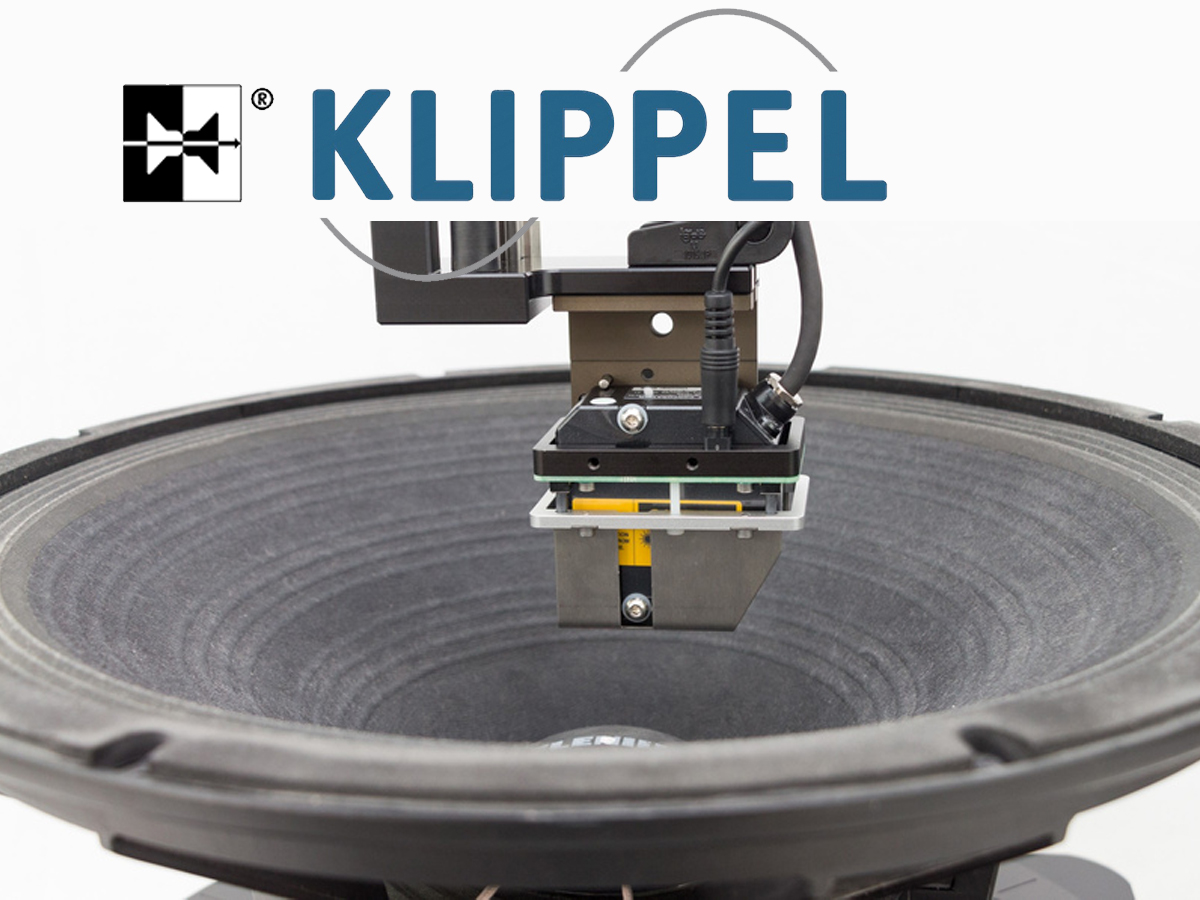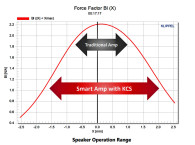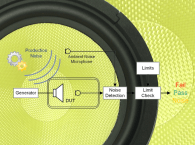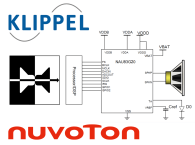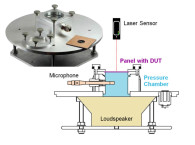Moreover KCS provides:
• More sound pressure output
• Active protection against overload
• Cancellation of nonlinear distortion
• Desired linear target performance
• Copes with aging, climate, and production variance
• Lowers cost, weight, and size
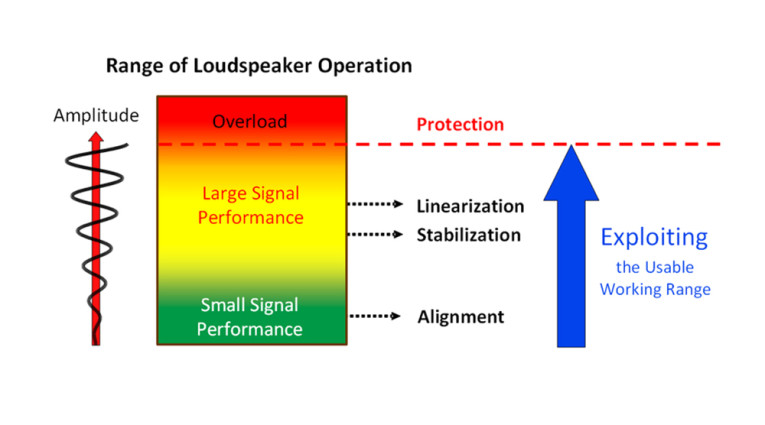
These features lead to an extension of the usable working range to increase bass and sound pressure level (SPL) or allow transducers to be made smaller, lighter and more cost effective. Additionally, transducer design can focus on increased efficiency by reducing parameter linearity to create a new generation of Green Speakers producing more acoustical output and less heat by requiring less energy.
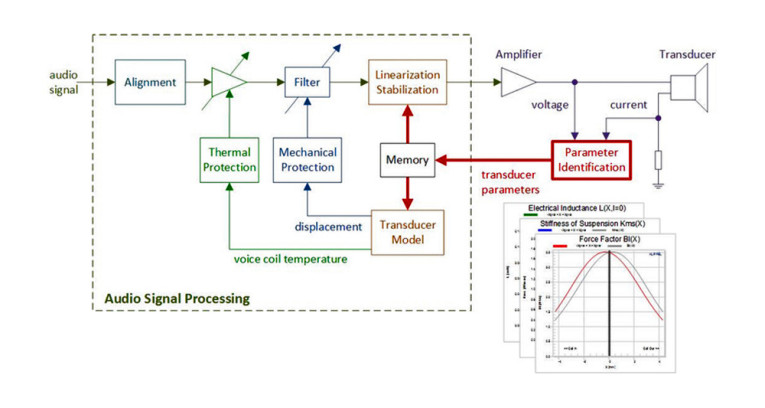
A Self-Learning System
KCS is a self-learning system that is based on a nonlinear physical model that provides an adaptive software solution with automatic parameter identification and that provides online learning with any audio signal. This new process uses the transducer itself as the sensor to identify the instantaneous transducer parameters by monitoring voltage and current at the speaker terminals. The nonlinearities indicate the transducer’s usable working range, eliminating time-consuming tuning by a human expert.
While playing music in online mode, KCS constantly monitors voltage and current at the speaker terminals to continuously adapt the internal model with time varying transducer properties (e.g., variances of mechanical stiffness, voice coil temperature and voice coil position). Based on the identified parameters, the nonlinear transducer model estimates precise state information such as voice coil displacement, which is required by the protection systems. Figure 2 provides a block diagram of the overall KCS process.

Distortion Reduction
KCS provides real-time distortion reduction that is based on a nonlinear physical speaker model such that linear and nonlinear distortions are reduced (see Figure 3). Due to the continuous identification of transducer variances, the behavior is kept constant over the speaker lifetime. Nonlinear and time-variant transducer parameters will cause nonlinear and linear distortion in the transducer’s output signal. KCS uses a nonlinear filter structure, which is a mirror image of the determined transducer model as depicted in Figure 4.
The harmonic and intermodulation distortions synthesized in the mirror filter are subtracted from the input signal before it is fed to the transducer. Thus, the distortions generated by the transducer are compensated, and a linear relationship between the input signal and the sound pressure output at any point in the sound field is established.
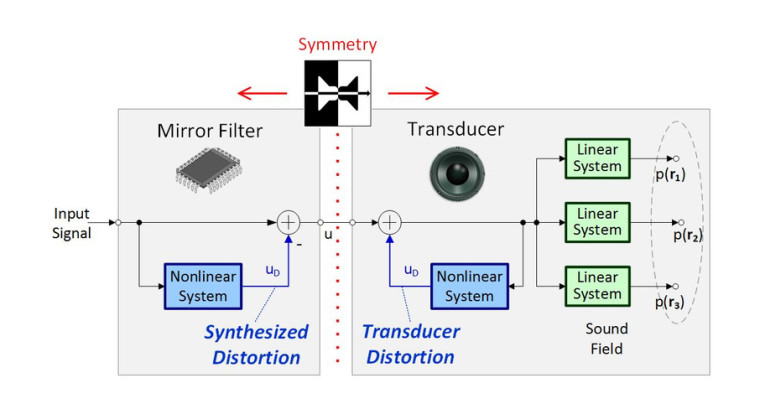
Another important aspect of KCS is its ability to provide active stabilization of voice coil position in the gap. This means that KCS is able to real-time shift the voice coil to the optimal position (see Figure 5) that can provide maximum peak-to-peak displacement and without the need for a mechanical sensor. For achieving maximum bass level, the peak-to-peak displacement must be maximized. This requires the voice coil being centered between the boundaries. However, the voice coil position is not stable because it depends on soft parts, which show high production variances and will change over time due to temperature, aging and other external influences (e.g., air pressure). In addition, transducer nonlinearities can cause dynamic voice coil position shifts due to instable behavior.
KCS detects the absolute position of the coil without a mechanical sensor by monitoring the input current and identifying an offset in the nonlinear curves. The detected offset can be actively compensated by supplying an appropriate DC voltage to the transducer via a DC-coupled amplifier. This ensures maximum positive and negative voice coil swing, giving maximum bass generated at high efficiency over the speaker’s lifetime.
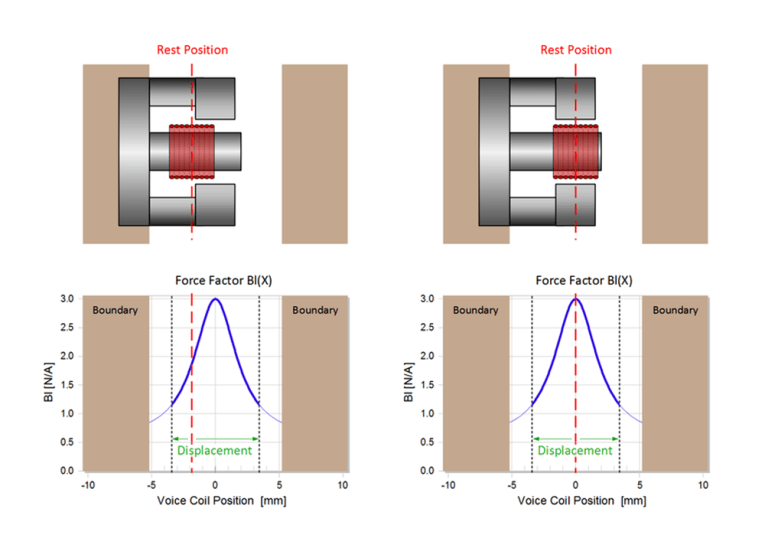
Another important aspect of KCS is the ability to perform system alignment, resulting in extended bass response for optimal transducer-enclosure alignment, which basically allow for an enclosure that is independent of transducer design. KCS ensures a constant linear transfer behavior between audio input and sound pressure output.
By exploiting the information about the transducer and the coupled mechanical and acoustical system (box, vent, and passive radiator), KCS automatically equalizes the overall transfer function to a desired alignment (e.g., Butterworth) by applying a pre-filter to the input signal (see Figure 6). Matching the transducer to a given enclosure is no longer required as cut-off frequency, Q-factors, and other alignment parameters can be adjusted in the software.
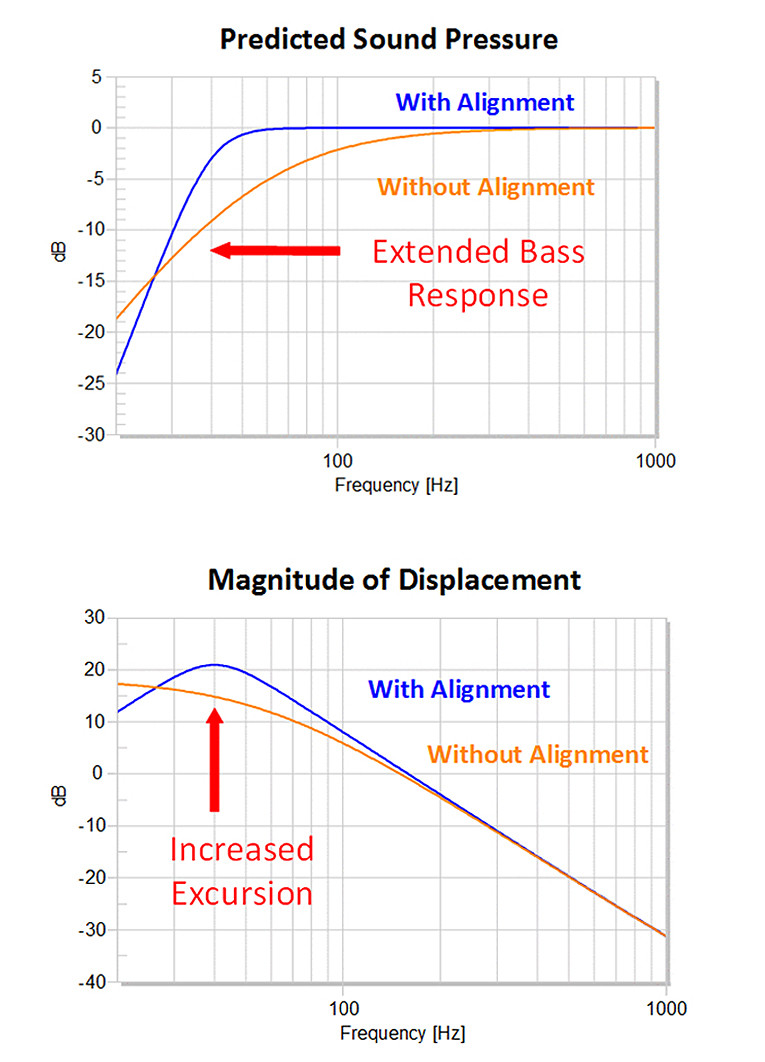
Reliable Transducer Protection
In terms of warranty replacement, KCS also provides reliable mechanical and thermal protection by exploiting the entire voice coil swing with a minimum of artifacts and very low to zero latency. Electro-mechanical transducers need active protection against mechanical overload at high excursion and against thermal overload at high input power to avoid excessive audible distortion or even destruction.
The nonlinear and thermal modeling combined with the permanent parameter identification of KCS provides a very accurate displacement and voice coil temperature estimation. Thus, the protection system can anticipate critical situations and attenuate signal components to prevent the overload.
While the thermal protection reduces the level of the entire input signal to reduce the electrical power, the mechanical protection system only attenuates low frequencies where the voice coil excursion is high. Hence, the maximum allowed excursion is fully utilized because the audio level can still be increased while only the excursion is restrained as shown in Figure 7. This technique allows the transducer to be reliably protected without latency and avoids artifacts generated by compressors and limiters that impair the perceived sound quality.
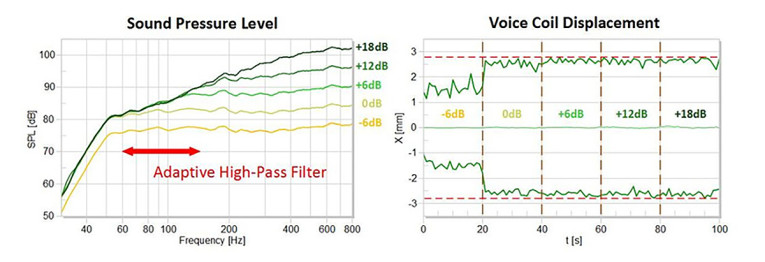
Green Speaker Design
All of the aspects of KCS combine to create what Klippel designates as Green Speaker Design. Green Speaker Design, when applied to certain categories of loudspeakers, provides increased efficiency and voltage sensitivity, more bass from smaller speakers, more SPL output with less heat, and in portable lifestyle products — longer battery life.
The unique features provided by KCS allow a change of paradigm in passive transducer and system design. Increasing efficiency and voltage sensitivity of the transducer has the highest priority for using available resources such as energy, size, weight, material, manufacturing effort, and cost. This leads to Green Speaker Design aiming at more output while needing less energy.
Many design choices dedicated to improving efficiency (e.g., using very soft suspensions or very nonlinear motors) were not available in the past due to the high risk of destruction and increased distortion. However, these issues can be solved with adaptive nonlinear control as the increased signal distortion is compensated and the protection system prevents any overload.
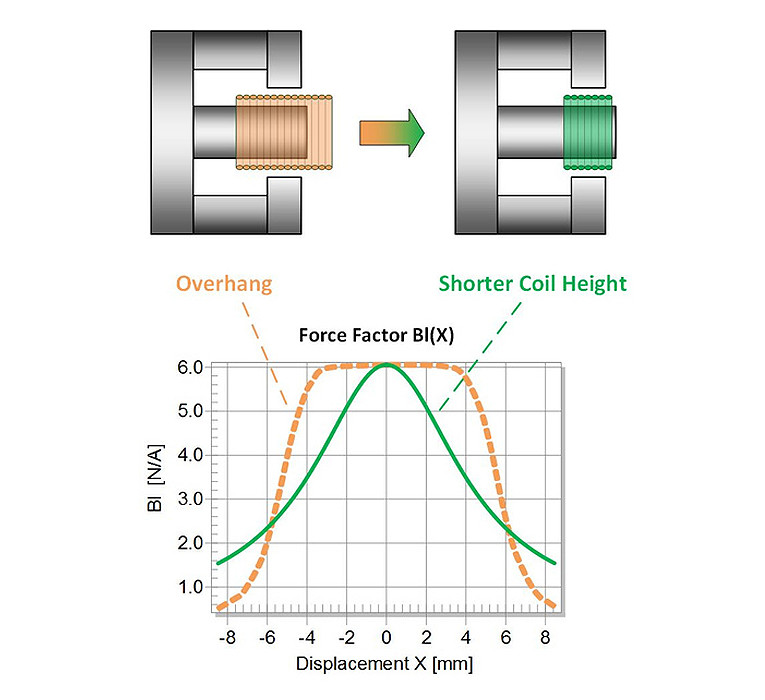
For instance, the voice coil height can be reduced significantly while the same pole plate, magnet, and other transducer parts are kept (see Figure 8). This significantly increases the efficiency and voltage sensitivity because the resistance Re and the moving mass Mms are reduced, given the formula for transducer efficiency:

On-Line Diagnostics
KCS extracts valuable information about the instantaneous properties of the transducer in the target application from the voltage and current signals (Figure 9). The parameter and state information reveal the influence of climate, acoustical load, and the progress of the natural aging process. Furthermore, the parameters can give early indications of defects, which may eventually lead to a complete breakdown. The diagnostic information provided by KCS can be used to operate the transducer safely at reduced amplitudes until the defective transducer is replaced. VC
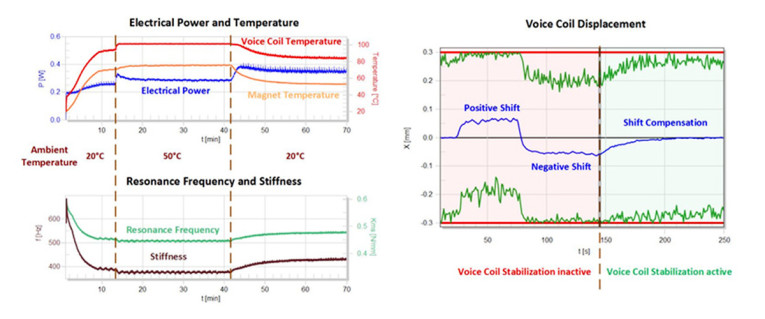
For more information about Klippel Controlled Sound (KCS), visit www.klippel.de
This article was originally published in Voice Coil, July 2019.



